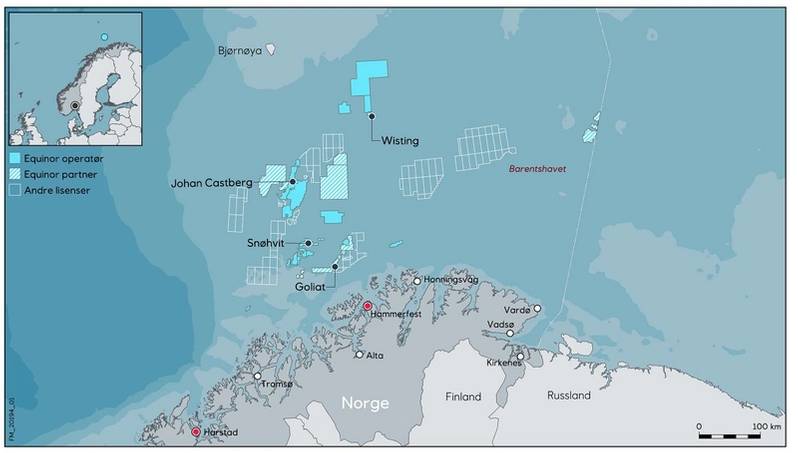
Norwegian oil and gas company Equinor has filed an impact assessment for the development and operation of the Wisting oil field in the Barents Sea. The plan for development and operation (PDO) is planned to be completed at the end of 2022.
The impact assessment to be issued for public consultation is covering both the development phase and the operations phase of the Wisting project in the Barents Sea. The Wisting discovery, located around 310 km north of Hammerfest was made by OMV in 2013. In December 2021, OMV sold its stake in the field to Lundin Energy.
Also in December, Equinor entered into an agreement with Lundin, under which Equinor will continue its Wisting operatorship into the operations phase.
Wisting license partners are Equinor Energy AS (35%), Lundin Energy Norway AS (35%), Petoro AS (20%), and INPEX Idemitsu Norge AS (10%).
The Wisting discovery contains close to 500 million barrels of oil equivalent. Expected investments are in the range of NOK 60 billion – 75 billion ($6,7 billion - $8,4 billion).
The development concept chosen for the Wisting development consists of a circular, floating production and storage unit (FPSO), with power from shore as an integrated part of the technical solution. The oil will be processed and stored on the FPSO before it is shipped to the market.
In the operations phase the Wisting power demand will be around 80 MW. The power cable will be around 340 km long. Water depth at the Wisting field is in the range of 390 - 418 meters.
"The impact assessment process is an open process, and its purpose is to ensure that players with an opinion on the development have an opportunity to express their view. The deadline for the consultation process is 12 weeks from publication," Equinor said.
'Major positive impacts'
"A development and operation of Wisting will have major positive impacts on society locally, regionally and nationally. Both the development phase and the operations phase will help create substantial value in Northern Norway and for Norwegian society," Equinor said.
"The Wisting field development will be a large and complex project, utilizing necessary experience and expertise both in the company and the industry. The chosen concept is robust and adapted to Barents Sea operation, while at the same time well suited for Norwegian suppliers to be able to compete for major assignments,” says Siv Irene Skadsem, vice president for new assets on the Norwegian continental shelf (NCS).
"The Norwegian share of goods and service deliveries to the field development is calculated to be more than NOK 35 billion, representing minimum 50 per cent of total investments. These calculations have been made before all contracts are awarded. Equinor aims to increase the Norwegian share as contracts are awarded," Equinor said.
Equinor also said that there would be major spinoffs in the operations phase, and the Norwegian share of the operating costs is estimated to total around NOK 1.7 billion per year over 30 years, which is the expected field life.
Several contracts have so far been awarded in relation to the Wisting project.
Aker Solutions won a contract for front-end engineering and design (FEED) of a floating production and storage unit (FPSO). The contract includes an execution option. FEED studies have also been awarded to Technip FMC, ABB, Leirvik, Aibel, OneSubsea Processing, IKM Ocean Design, Subsea 7, NOV, Baker Hughes Energy, NKT, and Siemens. This work will mainly be performed in Norway.
Supply, Helicopter base in Hammerfest Wisting Map - Credit: Equinor
Wisting Map - Credit: Equinor
Equinor said that plans called for both the supply base and the helicopter base to be established in Hammerfest.
"Distance and sailing time to the field, access to existing infrastructure and expertise as well as capacity and synergies with existing users are conditions that have been emphasized in the selection," Equinor said.
“When considering the location of operational support functions, it has been important to us to find a robust industrial solution that utilizes and builds on existing competence communities in Hammerfest and Harstad in a good and balanced way with a long-term perspective,” says Kristin Westvik, Equinor’s senior vice president for exploration and production north operations.
"To build on the communities that Equinor already has in Northern Norway, we want to split the operating model between Harstad and Hammerfest. We plan to establish an onshore control room and operational support tasks in Hammerfest, while functions related to administrative operation and other technical functions are to be in Harstad,” says Westvik.
The plans are being further detailed towards an investment decision to be made at the end of this year.



